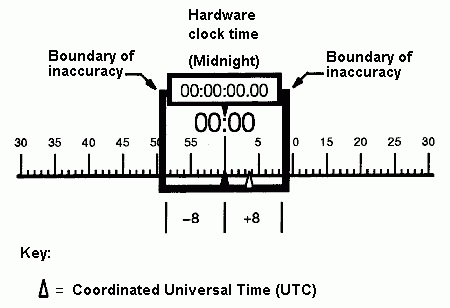Inaccuracy Values
In order to synchronize system clocks to the most accurate settings, DTS needs a way to determine the accuracy of time sources relative to each other and to UTC. This topic describes how DTS determines the relative accuracy of any time source that is available in the network.
DTS uses an inaccuracy value, or tolerance, to determine the relative precision of time values that it obtains from system clocks and external time-providers. This DTS feature effectively transforms each time value into an interval, or range, rather than a point on a continuum.
Inaccuracy values are determined by the following three factors:
· Drift - When reading a clock, DTS calculates the amount of time that the clock may have drifted since DTS previously read the clock. Drift is the largest component of most inaccuracy values.
· Communications Delay - The inaccuracy also contains the uncertain portions of the communications delays between systems. Although DTS compensates for processing delays, it cannot predict or directly measure the varying delays that occur on network links. The inaccuracy values that a clerk or server obtains from co-located systems on a LAN tend to be much lower than those obtained from servers outside the LAN.
· Leap Seconds - UTC time is measured by atomic clocks, which are extremely stable. The standard, however, keeps time based on the earth's position. Due to the slowing of the earth's rotation, it occasionally becomes necessary to advance UTC time by 1 second. These events are known as leap seconds. Leap seconds may occur in the final second of any month, and normally occur about once every 18 months. At the end of each month, DTS accounts for leap seconds by increasing all inaccuracy measurements by 1 second. DTS later adjusts the clocks to remove the extra second of inaccuracy if an external time-provider determines that a leap second did not actually occur.
Without DTS to correct it, a system clock's inaccuracy is always increasing. For example, suppose that a clock starts with a UTC time of 0:00:00.00 (midnight) and zero inaccuracy. Due to drift, when the clock next shows a time of 0:00:00.00, the inaccuracy is 8 seconds. UTC time may be 23:59:52.00 or 0:00:08.00, but is probably somewhere in between. Therefore, the system time is an interval that contains UTC time and is bounded by the inaccuracy, as shown in the following figure. Using the DTS format for displaying time, the combined time and inaccuracy interval is expressed as follows: 1993-08-03-00:00:00.000I08.000.
Time and Inaccuracy
